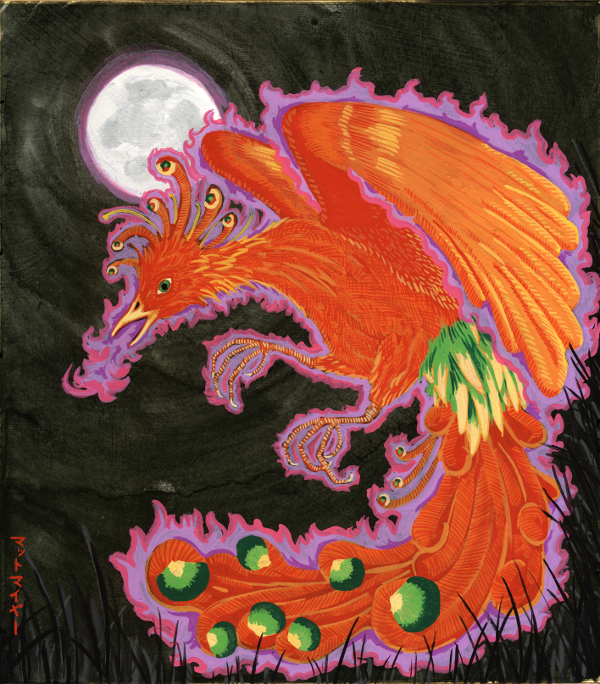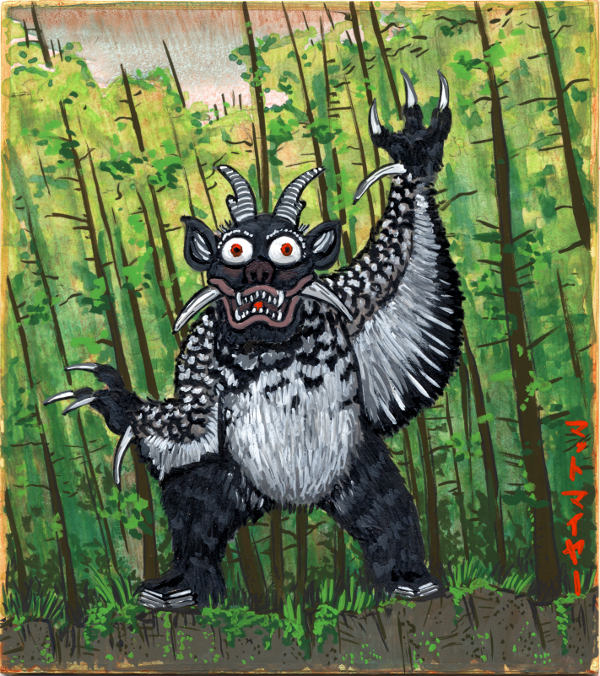There’s a little debate as to what specifically constitutes a “yokai.” A lot of times I will propose an idea, and my wife will yell at me, “That’s not a yokai!” And I’ll come back with, “Well Wikipedia says it is!” or some other lame retort. Wikipedia’s reliability aside, there are so many different kinds of supernatural creatures in Japanese folklore — yokai, obake, yurei, kami, demons, urban legends, and other supernatural/legendary creatures that don’t fit into specific categories — coming from so many different sources — Chinese folklore, Japanese folklore, Buddhism, Shintoism, made up by authors or artists — that it would probably be impossible to accurately catalog them all. And the fact is, while a lot of Japanese people today would say that such-and-such is technically not a yokai, many of the famous centuries-old yokai bestiaries have specifically referred to non-yokai as yokai, adding to the confusion.
So I just want to make a disclaimer now that some of these creatures may technically not be yokai; some may be ghosts, some may be kami, and other may just be legendary beasts. Today’s is a perfect example of such a “yokai.”
Hou-ou
This bird goes by a number of different names. It is often translated as a kind of phoenix, however that’s not exactly accurate because there are two other birds which go by that name over here (the fushicho, and the Middle-Eastern phoenix which we are familiar with). Wikipedia refers to it in English with an Anglification of its Chinese name, fenghuang, or as the Chinese phoenix. Technically probably not a yokai, this legendary bird comes to Japan through Chinese mythology.
The hou-ou is a very rare and regal bird. It represents virtue, grace, and the imperial line. Physically, it is a kind of chimera. It is said to have a bird’s beak, a swallow’s jaw, and a snake’s neck. The front half of its body is said to resemble a giraffe, the back half a deer. Its back resembles a tortoise’s shell, and its tail is like that of a fish. Its body symbolizes the six celestial bodies: the head is the sky, the eyes are the sun, the back is the moon, the wings are the wind, the feet are the earth, and the tail is the planets. Its feathers contain the five fundamental colors: black, white, red, blue and yellow. It is also sometimes depicted as having three legs! It’s quite a popular motif in older Japanese art, and you can see perhaps Japan’s most famous hou-ou on the roof of Byodo-in temple, also known as Phoenix Hall, in Kyoto. That same hou-ou is also printed on the back of the 10,000 yen note, so you know it’s a famous symbol.
Its name is also quite interesting. Originally hou-ou was two different birds: the hou and the ou (or in Chinese, the feng and the huang). The hou was the male bird and the ou was the female bird. Together they represented the union of yin and yang, masculinity and femininity, good and evil; cosmic balance. At some point, they merged into one single bird. At least in China, each part of the hou-ou’s body symbolizes a specific concept: the head represents virtue, the wing represents duty, the back represents propriety, the abdomen represents belief, and the chest represents mercy. I’m not sure exactly how much of this symbology continues today in Japan, but I would imagine that when the hou-ou was initially imported it carried as much importance in Japan as it did (and still does) in China.

Hou-ou
Alright, week 1 is finished! The first 7 yokai of the month! Tomorrow I will bring you number 8, and I will put the first week’s worth of yokai up on my Etsy store as signed, matted prints. | 描く妖怪について妻に質問をしてみることがありますが、時折彼女は”それは妖怪じゃない”と言います。そこで私は、”ウィキペディアでは妖怪と書いてあった”と言います。まぁ、ウィキペディアの信憑性についてはさておきまして、今日の妖怪についてご説明する前に、ここで少し”妖怪”について考えてみたいと思います。
妖怪について色々と調べてみる内に分かった事がありましたのでご紹介しましょう。
日本の言い伝えの中には多くの異なった種類の超自然的な生物が存在します。妖怪,お化け,幽霊,神,鬼,都市伝説,その他の超自然的な/伝説の生物などの既存のカテゴリーの中に分類できないもの達です。そしてそれらの生物にはそれぞれ多くの異なった背景があり、中国や日本の言い伝えから来ているものや、仏教,神道,作家や画家によって創造されたものなどあります。また、今日の多くの日本人が”厳密には妖怪ではない”としている生物は、多くの古い妖怪に関する本では”妖怪”として表記されている事もあり、それらの事がどうやら混乱を生んでいるようです。
そこで、ここに出てくる生物が厳密には妖怪ではないかもしれませんのでただ注意書きをしたいと思います。それらは幽霊かもしれませんし、神かもしれません。もしかしたら伝説の獣かもしれません。今回は、それについて絶好の”妖怪”だと思いますよ。
「今日の妖怪シリーズ」今日は鳳凰です。
この鳥は多くの異なった名前があります。よくみられるのはフェニックスという名前ですね。しかし、フェニックスと鳳凰は似ていますが完全に同じではありません。ウィキペディアによると、英語では鳳凰は中国での呼び名がそのまま使われており、fenghuang:フェンフォァンと呼ばれています。鳳凰は中国の伝説が日本に伝わったものであり、厳密には妖怪ではないかもしれませんね。
鳳凰はとても希少で荘厳な鳥であり、美徳・気品・皇統を表し、容姿はキメラに似ています。
日本ではその容姿は、鳥の嘴に燕の顎、蛇の首を持つと言われ、体の前半分は麒麟、後ろ半分は鹿から成り、背中は亀で尾は魚であるとされています。体は6つの天体を象徴(頭は空、目は太陽、背中は月、翼は風、足は地球、尾は惑星)しており、羽は五つの原色(黒・白・赤・青・黄)があります。鳳凰は時に足が3本で描かれている事もあります!
鳳凰は古い日本の芸術作品の中で特に人気があったモチーフです。日本で最も有名な鳳凰は、鳳凰堂があることで知られている京都の平等院の屋根の上に見ることができます。それと同じ鳳凰を1万円札の後ろに見つけられますよ。
鳳凰の名前にはおもしろい言い伝えがあります。かつて鳳と凰(中国ではfengとhuang)は別々の鳥であり、鳳は雄、凰は雌であったといわれています。そして彼らは陰と陽、男らしさと女らしさ、善と悪の調和を保つ存在でありました。
何かの時点で彼らは一つの鳥になりました。中国の言い伝えでは、鳳凰の身体には特別なコンセプト(頭は美徳、翼は義務、背中は礼節、腹部は信念、胸部は慈悲)があるといわれています。中国の言い伝えによる鳳凰や、象徴されるものの重要性がどのくらい日本に伝わったかは定かではありませんが、中国で伝えられているものと現在の日本における鳳凰とでは違いがみられ、伝わった時から徐々にそのあり方が変わってきているようにも思われます。

鳳凰
「鳳凰」の絵は私のEtsyストアで購入が可能になっています。オリジナルの「鳳凰」の購入がご希望でしたら、こちらのお問い合わせフォームからご依頼をおねがいします。世界に1枚のオリジナルですので、売れてしまう場合もございます・・・。ご注文はお早めに。








